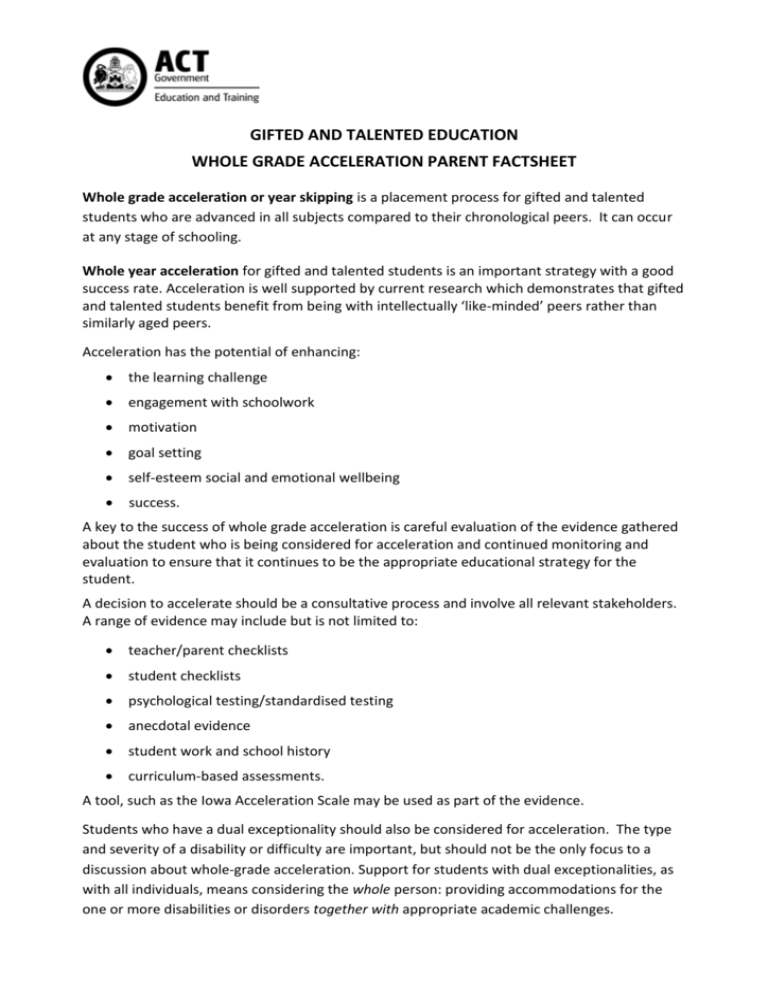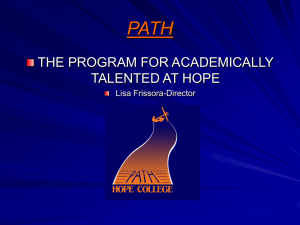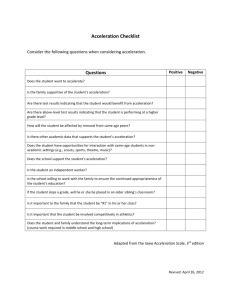Whole-grade Acceleration - Education and Training Directorate
advertisement

GIFTED AND TALENTED EDUCATION WHOLE GRADE ACCELERATION PARENT FACTSHEET Whole grade acceleration or year skipping is a placement process for gifted and talented students who are advanced in all subjects compared to their chronological peers. It can occur at any stage of schooling. Whole year acceleration for gifted and talented students is an important strategy with a good success rate. Acceleration is well supported by current research which demonstrates that gifted and talented students benefit from being with intellectually ‘like-minded’ peers rather than similarly aged peers. Acceleration has the potential of enhancing: the learning challenge engagement with schoolwork motivation goal setting self-esteem social and emotional wellbeing success. A key to the success of whole grade acceleration is careful evaluation of the evidence gathered about the student who is being considered for acceleration and continued monitoring and evaluation to ensure that it continues to be the appropriate educational strategy for the student. A decision to accelerate should be a consultative process and involve all relevant stakeholders. A range of evidence may include but is not limited to: teacher/parent checklists student checklists psychological testing/standardised testing anecdotal evidence student work and school history curriculum-based assessments. A tool, such as the Iowa Acceleration Scale may be used as part of the evidence. Students who have a dual exceptionality should also be considered for acceleration. The type and severity of a disability or difficulty are important, but should not be the only focus to a discussion about whole-grade acceleration. Support for students with dual exceptionalities, as with all individuals, means considering the whole person: providing accommodations for the one or more disabilities or disorders together with appropriate academic challenges. Whole-grade Acceleration Flowchart STEP 1 – Nomination Guided by the Education and Training Directorate’s Gifted and Talented Students Policy, the teacher, parent/carer or student notifies the principal of a gifted and talented student’s potential candidacy for whole-grade acceleration as outlined in the school documentation for all gifted and talented students. STEP 2 – Assessment for Identification Evidence is collected and reviewed, such as: Teacher/parent checklists Psychological testing/Standardised tests Self identification Interviews Anecdotal evidence Student work Curriculum-based assessments and reporting School history. Identification Tool: Iowa Acceleration Scale (IAS) Guide for K-8 candidates. STEP 3 - Validation Principal determines whole-grade acceleration suitability of student, based on the evidence provided. If Whole-grade acceleration is not recommended, school explores appropriate educational opportunities for the student. Student may be nominated for consideration as a potential candidate for whole-grade acceleration at a later date, based on new evidence. If the student is nominated for consideration as a potential candidate at a later date, the process recommences from Step 2. If Whole-grade acceleration recommended continue to Step 4. STEP 4 – Placement and Modification Recommendation Principal consults with parents/carers and other professionals including school psychologist, as required, to determine the one or more provisions that will best meet the needs of the student. The School Network Leader (SNL) is consulted if acceleration placement is in a different school/sector. STEP 5a - Intervention Whole-grade acceleration: student advancement of one or more learning years actioned. STEP 5b - Intervention Developmentally appropriate modifications are made to the student’s program. STEP 5c - Intervention Additional educational options e.g. concurrent enrolment, mentoring arranged. STEP 6 – ILP An Individual Learning Plan (ILP) is required and completed. ILP includes specific skill training to meet potential gaps that result from whole-grade acceleration placement. STEP 7 – Evaluation Continued evaluation and identification occurs, throughout schooling, as an ongoing process with a diagnostic purpose. STEP 8 – Transition Process The school implements a transition process that lists and describes the developmentally appropriate educational provisions and strategies provided as the student progresses through their schooling.







